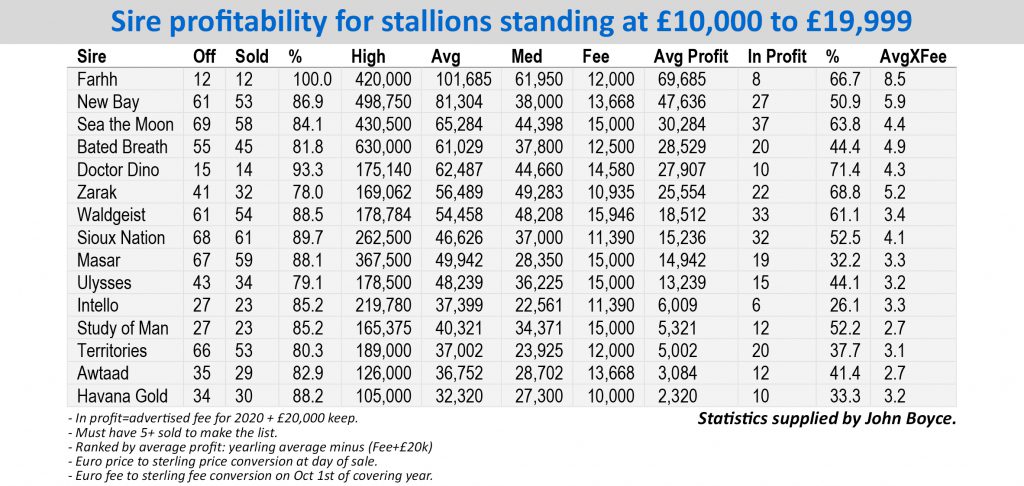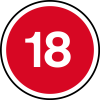As we move into the third tier of our examination of stallions by yearling profitability, the name at the top of the list for those standing between the equivalent of £10,000 and £19,999 perhaps provides an example of how rarity drives demand.
On paper, the Dalham Hall Stud-based Farhh (GB) has an awful lot going for him. A son of Pivotal (GB) out of a dual Group 1 winner over a mile and a half, he was lightly raced, with just one winning appearance in each of his two- and three-year-old seasons. Then at four, when things fell into place for him, he had Nathaniel (Ire) then Frankel (GB) holding him off the top spot in three consecutive Group 1 races. In total, Farhh ran second in four Group 1s that season, in the Eclipse, Sussex, International and Prix du Moulin, being beaten just a head in the latter by Moonlight Cloud (GB). The infrequency of his appearances resumed in his five-year-old season but boy was he worth waiting for, as he won the Lockinge and the Champion S. to round off his career in style.
Unfortunately things haven’t gone swimmingly for the handsome Farhh at stud, as his career has been dogged by poor fertility. It has also been liberally sprinkled with excellence.
From eight crops of foals to date, the largest number recorded in one year was 39 in 2019. The previous year only 18 Farhh foals were born, and there were 14 in 2022. From a total of 189 foals eligible to have raced so far he has had 149 runners and 89 winners, including 17 stakes winners. His seven group winners give a snapshot of the diversity one can expect when it comes to distance, which is perhaps no surprise given the speed and stamina influences in his own pedigree. His Group 1 winners King Of Change (GB) and Fonteyn (GB) are both essentially milers; the Group 3 winners Wells Farhh Go (GB) and Dee Ex Bee (GB) were both talented stayers, while another, Far Above (GB), was an extremely fast winner of the G3 Palace House S. at Newmarket. Far Above and King Of Change are both now at stud, and it will be interesting to see how much of a boost they can give to the Pivotal male line to enhance the good work being done primarily in France by Siyouni (Fr).
For the benefit of this exercise, as previously stated in Part I and Part II, the stallions are examined in four key price brackets according to their yearling sales returns of 2022 set against their fees at the time of covering. The average profit has been determined by the stallion’s fee plus a figure of £20,000 for keep costs. The profitable stallions featured must have had at least five yearlings sold in 2022 to make the list and prices have been converted to sterling from Euros according to the conversion rate on the day of the sale.
With an average yearling price which was 8.5 times his 2020 fee of £12,000, Farhh was the clear leader in this field. Twelve of the 22 member of his 2021 crop were offered for sale, with the ten sold returning an average profit of £69,685. The only reason I have not given Farhh the gold medal which his results certainly deserve is that his poor fertility does present something of a risk, but that is for each breeder to weigh up for themselves as he is quite clearly a very good stallion.
Click Table To Enlarge.
While the scarcity of Farhh’s offspring could well have been a driver in his sales returns, the same cannot be said for New Bay (GB), who had 53 of his 61 yearlings offered sold for an average which was almost six times his 2020 fee. That figure of €15,000 was the lowest he stood for, and well done to those breeders who caught him at that fee in 2019 and 2020. Subsequently he has shot up to €37,000 in 2022, and that was then doubled to his current high of €75,000. One of his three Group 1 winners to date, Bayside Boy (Ire), has just joined New Bay on the roster at Ballylinch Stud, while the other two, Saffron Beach (Ire) and Bay Bridge (GB) remain in training with further lofty targets in their sights.
In fee, New Bay has moved up two tiers on these stallion tables in just two years. His average profit on the yearlings sold last year was £47,636, and with a likely upturn in the quality of mares covered in line with his fee, it is fair to expect for his yearling average to continue to climb as long as those results on the track keep coming.
Sea The Moon (Ger) bucked a certain number of trends merely by being recruited to stand at Lanwades Stud in the first place. Not many winners of the German Derby make it to studs outside Germany, and not many sons of Sea The Stars (Ire) are afforded places at Flat studs, a situation that is as ridiculous as it is regrettable.
Early on in his stud career, Sea The Moon caught the imagination of Australian buyers who switched their attention to buying foals and yearlings as the prices for horses in training climbed, and he has a decent strike-rate with his offspring to have ended up down under. They include the G1 Caulfield Cup winner Durston (GB), G3 N E Marion Cup winner Favorite Moon (Ger), and the Group 3-placed Pondus (GB).
As he embarks on his ninth covering season, Sea The Moon’s popularity remains strong. His yearlings of 2022, conceived the last year he stood for £15,000, returned average profit of £30,284 from 58 sold. Though his fee has since risen to £25,000, he remains that rare middle-distance horse to be holding his own in the centre ground of the stallion market.
With such illustrious stud-mates as Frankel and Kingman (GB), Bated Breath (GB) can be in danger of being under-appreciated but he should not be, for he is a mid-range stallion who offers great value in a commercial marketplace. A Group 1 winner in Europe would be a boost to his profile–presently his sole top-level winner, Viadera (GB), posted her best performance in America–but he has had plenty knocking on the door, including the Group 2 winners Worth Waiting (GB), Daahyeh (GB), and Space Traveller (GB). The last named, twice a Grade I runner-up in the States, has recently joined the roster at Ballyhane Stud.
Bated Breath‘s fee has increased to £15,000 from the £12,500 paid for the nomination fee when these yearlings were conceived, but that keeps him within this bracket, and when considering a yearling average of £61,029 and average profit of £28,529 from the 45 sold through the ring last year, he remains an enticing prospect for breeders.
Doctor Dino (Fr) is primarily considered a National Hunt stallion, with the likes of Sceau Royal (Fr), La Bague Au Roi (Fr) and Sharjah (Fr) to his credit, but he should be regarded as a dual-purpose option, for he is also the sire of G1 Prix de Diane runner-up Physiocrate (Fr) and Group 3 winners Golden Legend (Fr) and Villa Rosa (Fr). Admittedly those three Flat horses named were all bred by Henri and Antonia Devin at Haras du Mesnil, where Doctor Dino stands, but if we are to learn, then it should be from the best, and the Couturié/Devin family has proved for many years to be extremely capable of producing top-class Flat runners.
Like his sire Muthathir (GB) before him, Doctor Dino can cut it under both codes, and he has gradually worked his way up from an opening fee of €3,000 to his current high of €20,000. He stood at €16,000 when these yearlings were conceived, and showed a decent average profit of £27,907 for the 14 sold in 2022. There aren’t many male-line descendants of Sharpen Up left at stud in Europe (Jack Hobbs is another, but he too is marketed primarily as a jumps sire), so it would be pleasing to see Doctor Dino have broader appeal to Flat breeders.
The more obvious French stallion high in this list, from a Flat perspective at least, is Zarak (Fr). Considering that his pedigree stretches back ten generations and 100 years to Mumtaz Mahal (GB) and the foundation of the Aga Khan Studs, he really would be a fitting stallion to make it to the top, especially as a son of the celebrated Zarkava (Fr). He is making all the right noises, with nine stakes winners from his first two crops as well as two Classic place-getters in La Parisienne (Fr) and Times Square (Fr), and there is a general clamour for his young stock. His opening fee of €12,000 held solid though his first four seasons until rising to €25,000 last year and €60,000 this year. This is the territory in which stallions start to get found out, but with the might of the Aga Khan broodmare band behind him, along with support from plenty of outside breeders, Zarak has a decent chance of taking another big step forward. Last year his yearlings sold for five times his 2020 fee and showed average profit of £25,554.
The G1 Keeneland Phoenix S. winner Sioux Nation made an extremely promising start to his stud career with his first runners in 2022. His tally of winners was such that in any normal year he would have been champion first-season sire, but he came up against another prolific youngster in Havana Grey (GB), who had the edge when it came to the number of stakes winners. Sioux Nation, one of the last of Scat Daddy’s sons to retire to Coolmore, was not lacking in this regard himself, and Lakota Sioux (Ire) and Sydneyarmschelsea (Ire) both won Group 3 races, while Matilda Picotte (Ire) landed the Listed Bosra Sham S. and was third in the G2 Lowther S.
His second-crop yearlings were conceived off his opening fee of €12,500. This dipped to €10,000 for two years before bouncing up to €17,500 for the coming season on the back of that promising start. Even at this new fee, Sioux Nation still looks a profitable option if he can build on his debut season with runners, for his 61 yearlings sold last year fetched an average price of £46,626 (four times his fee) and average profit of £15,236.
The 2020 covering season saw three very smart recruits to the stallion ranks in Britain and Ireland. Derby winner Masar (Ire) joined the Darley team in Newmarket, the town which has also become home to the Niarchos family’s Prix du Jockey Club winner Study Of Man (Ire), who is at Lanwades Stud, while the Arc winner Waldgeist (GB), who was only narrowly denied the previous year’s Jockey Club when beaten a short-head by Brametot (Ire), retired to Ballylinch Stud. All three have top-drawer pedigrees to match their racing records and, while their first two-year-olds will be unleashed this season, it is fair to expect all of them to be better represented once that crop turns three.
That said, two things should be kept in mind when considering Masar. His sire New Approach (Ire), a fellow Derby winner, had been champion two-year-old and with his first crop he pulled off the extremely rare feat of being represented by three juvenile stakes winners at Royal Ascot. Masar was no slouch at two himself, beating the smart sprinter Invincible Army (Ire) over six furlongs on debut in May before winning the G3 Solario S. and finishing third in the G1 Prix Jean-Luc Lagardere. He could well be in the mix in the first-season sires’ table this year.
Masar’s first yearlings sold for an average which was 3.3 times his opening fee of £15,000. He has dropped only fractionally to £14,000 but it may well be a good time to use him. His average profit on 59 yearlings sold was £14,942.
Waldgeist outstripped that from an opening fee of €17,500, with 54 sold for an average 3.4 times that mark and average profit of £18,512. He was of course a Group 1 winner at two, and his stock looked pretty tidy, as he is himself, and may well not take too long to come to hand. With a drop in fee to €12,500 for 2023, again this could well be a good time to strike for this well-bred son of Galileo (Ire).
Just as Waldgeist will have been lent support by the powerful Ballylinch partners, including his co-breeder Gestut Ammerland, as well as Newsells Park Stud, so will Study Of Man been supported by the Niarchos family and Kirsten Rausing at Lanwades. The latter was responsible for 25 of Study Of Man’s first crop of foals, including ten from her ‘AL’ family and a filly out of Group 1 winner Madame Chiang (GB) (Archipenko), while other notable first-crop members include a half-brother to Derby winner Desert Crown (GB) (Nathaniel {Ire}) who was retained by breeder Gary Robinson of Strawberry Fields Stud. Juddmonte Farms, Gestut Fahrhof, Blue Diamond Stud, and Hascombe & Valiant Stud were among the other major operations to back the son of Deep Impact (Jpn) and grandson of Miesque (Nureyev).
With some notable owner-breeders involved it wasn’t a surprise that not many of Study Of Man’s yearlings came onto the market, but of the 27 that did, 23 were sold for an average of £40,321 at an average profit of £5,321. His stud fee was adjusted from an opening £15,000 to £12,500 for his next two seasons, and that is where it remains for 2023, which seems an extremely fair price for a horse with a pedigree of hugely international significance.
The Niarchos family’s Flaxman Stables Ireland was also responsible for breeding Ulysses (Ire), the son of a Derby winner and Oaks winner in Galileo and Light Shift (Kingmambo). He does need to have a big year this year, but there have been glimmers of potential from Ulysses’s first two crops to date, with Piz Badile (Ire) winning the G3 Ballysax S. and finishing second in the Irish Derby, while Holloway Boy (GB) announced his talent in no uncertain terms when winning the Listed Chesham S. on his audacious debut at Royal Ascot.
At Cheveley Park Stud, his fee has dropped from an opening £30,000 to £10,000 but there were still plenty of Ulysses supporters at the yearling sales, where 34 of his yearlings sold for an average of £48,239, representing average profit of £13,239 from his 2020 fee of £15,000. There will be plenty of people happy to see Ulysses have a noteworthy season in 2023.
Value Podium:
Gold: Bated Breath
Silver: Sea The Moon
Bronze: Waldgeist
The post Value Sires Part III: Farhh and Away appeared first on TDN | Thoroughbred Daily News | Horse Racing News, Results and Video | Thoroughbred Breeding and Auctions.







